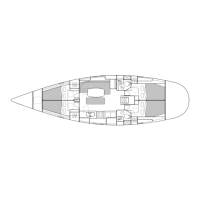Do you have a question about the BENETEAU 40 and is the answer not in the manual?
Explains the CE mark and compliance with Recreational Craft Directive and ISO standards.
Defines design categories (A-D) for different sea conditions and their wave/wind force ratings.
Provides a breakdown of weight estimations for various equipment and design categories.
Offers guidelines for inspecting and maintaining wire and synthetic rigging components.
Identifies symbols and diagrams showing the location of emergency exits and extinguisher discharge apertures.
Details requirements, advice on placement, capacity, and usage of portable fire extinguishers.
Offers preventive advice on fire safety, including handling flammable materials and crew awareness.
Discusses factors affecting visibility from the helm station and the importance of watch and COLREGS.
Explains risks to stability, flooding, and proper handling to maintain safety at sea.
Shows the deck layout for a standard roller furling mast, detailing block and line routing.
Describes the routing of halyards, inhaul, and topping lift on the port side of the mast.
Lists the specific Lewmar blocks and shackles used for halyards and inhauls on the port mast steps.
Describes halyard routing for a classic mast, including jammer and winch usage.
Lists Lewmar blocks and shackles for spinaker pole lift and halyard on the starboard side.
Details the operation and stowage of the foldaway swimming ladder.
Emphasizes the importance of closing hatches and portholes for safety, especially in rough seas.
Offers critical advice on engine operation, ventilation, and carbon monoxide safety.
Illustrates the layout of the fuel tank, filler, gauge, filter, and cutoff valve.
Explains the accessibility and use of the emergency tiller in case of steering failure.
Details safety precautions for the 12V system, battery handling, and wiring conventions.
Explains the function of each switch and indicator on the main electric panel.
Shows the physical location of various electrical components, switches, and appliances onboard.
Illustrates the correct operation of battery switches for different scenarios and warns against improper use.
Explains the operation of the propane stove, including safety warnings for gas detection and usage.
Provides a diagram illustrating the propane locker, regulating kit, LPG tank, and solenoid valve arrangement.
Details the step-by-step operation of the fresh water system, including bleeding air and leak checks.
Depicts the layout of fresh and black water tanks, filler points, vents, and the water pump.
Lists and visually indicates the location of various seacocks and thru-hulls on the boat's plan.
Explains the operation of quarter-turn seacocks and provides safety advice for maintenance.
Offers guidance on maintaining seacocks, using plugs for emergencies, and checking clamps.
Identifies and labels essential fittings like mooring cleats, bow fitting, chain locker, and windlass.
Details the correct positioning of lifting straps and cradle for safe hauling and trailering.
| Engine | Yanmar 40 HP |
|---|---|
| Fuel Capacity | 200 L |
| Cabins | 2 or 3 |
| Hull Length | 11.98 m |
| CE Certification | A |
| Berths | 4-6 |












